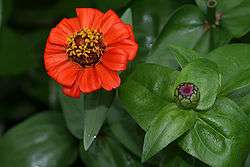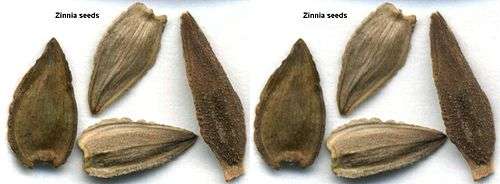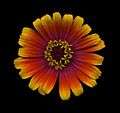Zinnia
| Zinnia | |
|---|---|
 | |
| Zinnia × hybrida flower and foliage | |
| Scientific classification | |
| Kingdom: | Plantae |
| (unranked): | Angiosperms |
| (unranked): | Eudicots |
| (unranked): | Asterids |
| Order: | Asterales |
| Family: | Asteraceae |
| Subfamily: | Asteroideae |
| Tribe: | Heliantheae[1][2] |
| Genus: | Zinnia L. |
| Type species | |
| Chrysogonum peruvianum L. | |
| Synonyms[2][3] | |
| |
| Stereo image | ||
| ||
| ||
| ||
| ||
| Zinnia seeds resemble arrow heads |
Zinnia is a genus of plants of the sunflower tribe within the daisy family.[4][5] They are native to scrub and dry grassland in an area stretching from the Southwestern United States to South America, with a centre of diversity in Mexico. Members of the genus are notable for their solitary long-stemmed flowers that come in a variety of bright colors. The genus name honors German botanist Johann Gottfried Zinn (1727–59).[6]
Description
Zinnias are annuals, shrubs, and sub-shrubs native primarily to North America, with a few species in South America.[7]:338- Most species have upright stems but some have a lax habit with spreading stems that mound over the surface of the ground. They typically range in height from 10 to 100 cm tall (4" to 40").[8] The leaves are opposite and usually stalkless (sessile), with a shape ranging from linear to ovate, and a color ranging from pale to medium green. The flowers have a range of appearances, from a single row of petals to a dome shape. They may be white, chartreuse, yellow, orange, red, purple, or lilac.[6]
Species
- Zinnia acerosa - Utah Arizona New Mexico Texas Coahuila, Durango, Nuevo León, San Luis Potosí, Michoacán, Zacatecas, Sonora
- Zinnia americana - Guerrero, Jalisco, Michoacán, México State, Nayarit, Veracruz, Oaxaca, Chiapas, Guatemala, Honduras, Nicaragua
- Zinnia angustifolia - Jalisco, Durango, Chihuahua, Sinaloa, San Luis Potosí
- Zinnia anomala - Texas, Coahuila, Nuevo León
- Zinnia bicolor - Chihuahua, Durango, Jalisco, Guanajuato, Nayarit, Sinaloa
- Zinnia citrea - Chihuahua, Coahuila, San Luis Potosí
- Zinnia elegans from Jalisco to Paraguay; naturalized in parts of USA
- Zinnia flavicoma - Michoacán, Oaxaca, Guerrero, Jalisco
- Zinnia grandiflora - Arizona New Mexico Texas Oklahoma Kansas Colorado Tamaulipas, Nuevo León, Coahuila, Chihuahua, Sonora
- Zinnia haageana - Guanajuato, Jalisco, Michoacán, México State, Oaxaca
- Zinnia juniperifolia - Tamaulipas, Nuevo León, Coahuila
- Zinnia maritima - Guerrero, Colima, Jalisco, Nayarit, Sinaloa
- Zinnia microglossa - Guanajuato, Jalisco
- Zinnia oligantha - Coahuila
- Zinnia palmeri - Colima, Jalisco
- Zinnia pauciflora Phil.
- Zinnia peruviana - widespread from Chihuahua to Paraguay including Galápagos and West Indies; naturalized in parts of China, South Africa, USA
- Zinnia pumila A.Gray
- Zinnia purpusii - Chiapas, Guerrero, Colima, Jalisco, Puebla
- Zinnia tenuis - Chihuahua
- Zinnia venusta - Guerrero
- Zinnia violacea - Mexico, Central America, Colombia, Venezuela
- Zinnia zinnioides (Kunth) Olorode & Torres
- formerly included[2]
- Zinnia bidens - Glossocardia bidens
- Zinnia liebmannii - Philactis zinnioides
Zinnia elegans, also known as Zinnia violacea, is the most familiar species, originally from the warm regions of Mexico being a warm–hot climate plant. Its leaves are lance-shaped and sandpapery in texture, and height ranges from 15 cm to 1 meter.[6]
Zinnia angustifolia is another Mexican species. It has a low bushy plant habit, linear foliage, and more delicate flowers than Z. elegans – usually single, and in shades of yellow, orange or white. It is also more resistant to powdery mildew than Z. elegans, and hybrids between the two species have been raised which impart this resistance on plants intermediate in appearance between the two. The Profusion series, with both single and double-flowered components, is bred by Sakata of Japan, and is among the most well-known of this hybrid group.
Zinnias seem to be a favorite of butterflies, and many gardeners add zinnias specifically to attract them.[11][12]
Uses
Zinnias are popular garden flowers because they come in a wide range of flower colors and shapes, and they can withstand hot summer temperatures, and are easy to grow from seeds.[13] They are grown in fertile, humus-rich, and well-drained soil, in an area with full sun. They will reseed themselves each year. Over 100 cultivars have been produced since selective breeding started in the 19th century.
Zinnia peruviana was introduced to Europe in the early 1700s. Around 1790 Z. elegans (Zinnia violacea) was introduced and those plants had a single row of ray florets which were violet. In 1829, scarlet flowering plants were available under the name 'Coccinea'. Double flowering types were available in 1858, coming from India, and they were in a range of colors including shades of reds, rose, purple, orange, buff, and rose stripped.[7]:338-
A number of species of zinnia are popular flowering plants, and interspecific hybrids are becoming more common.[7]:344- Their varied habits allow for uses in several parts of a garden, and their tendency to attract butterflies and hummingbirds is seen as desirable. Commercially available seeds and plants are derived from open pollinated or F1 crosses, and the first commercial F1 hybrid dates from 1960.[7]:344-
Beyond Earth
In January 2016, NASA announced that a zinnia which had blossomed on the International Space Station was the first flower ever grown outside the Earth's biosphere.[14] This claim was quickly refuted by news media.[15][16]
Companion plants
In the Americas their ability to attract hummingbirds is also seen as useful as a defense against whiteflies, and therefore zinnias are a desirable companion plant, benefiting plants that are intercropped with it. Zinnias are grown in the summer.
Gallery
See also
References
- ↑ "Genus Zinnia". Taxonomy. UniProt. Retrieved October 14, 2010.
- 1 2 3 4 Flann, C (ed) 2009+ Global Compositae Checklist
- ↑ "Genus: Zinnia L.". Germplasm Resources Information Network. United States Department of Agriculture. October 5, 2007. Retrieved October 14, 2010.
- ↑ Linnaeus, Carl von. 1759. Systema Naturae, Editio Decima 2: 1189, 1221, 1377 in Latin
- ↑ Tropicos, Zinnia L.
- 1 2 3 Flora of North America, Vol. 21 Page 7, Zinnia Linnaeus
- 1 2 3 4 Neil Owen Anderson (October 2007). Flower Breeding and Genetics: Issues, Challenges and Opportunities for the 21st Century. Springer. ISBN 978-1-4020-6569-9.
- ↑ http://www.efloras.org/florataxon.aspx?flora_id=1&taxon_id=135326
- ↑ Biota of North America Program 2013 county distribution maps
- ↑ The Plant List search for Zinnia
- ↑ Bees pollinate the florets of Zinnias. The rarest of zinnias are white. Zinnias can be dwarf with more flowers than tall zinnias. Zinnias can only be grown in the seeds. Once dried the seeds are useful for making teas. Dried florets have been good for reproducing the next generation. It won't produce the same color. The parent will die and the offspring will produce mixed of colors. "Monarch Watch". The Kansas Biological Survey, Univ of Kansas. May 27, 2008. Retrieved May 27, 2008.
- ↑ "Saving Butterflies Insect Ecologist Spearheads Creation of Oases for Endangered Butterflies". ScienceDaily. January 1, 2005. Retrieved May 27, 2008.
- ↑ Singh, A.K. (1 January 2006). Flower Crops: Cultivation and Management. New India Publishing. pp. 403–. ISBN 978-81-89422-35-6.
- ↑ Johnston, Ian (16 January 2016). "First flower grown in space shows there is 'other life' out there". The Independent newspaper.
- ↑ Taylor, Lin (18 January 2016). "Is this the first ever flower grown in space?". CNN.
- ↑ Feltman, Rachel (19 January 2016). "NASA astronauts just made flowers bloom in space – but they’re not actually the first". The Washington Post.
External links
![]() Media related to Zinnia at Wikimedia Commons
Media related to Zinnia at Wikimedia Commons
![]() Data related to Zinnia at Wikispecies
Data related to Zinnia at Wikispecies





